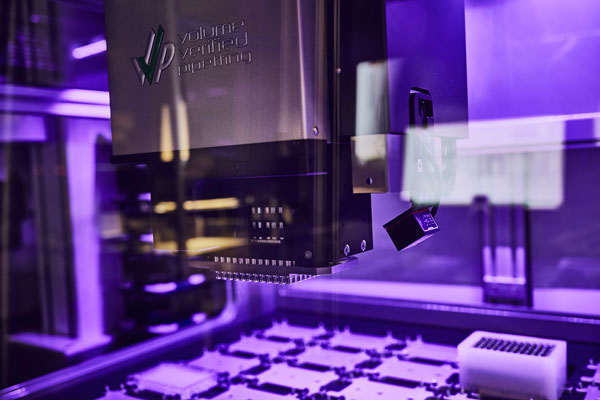How fast a bacterium evolves resistance varies strongly between different antibiotics and bacteria. Sometimes resistance develops so fast that the antibiotic is essentially useless for clinical applications. In more encouraging cases, resistance occurs so slowly that the same antibiotic can be used for years or even decades. The ability to predict which antibiotic will avoid resistance longest for a particular bacterium would help to put our use of antibiotics on a more sustainable trajectory. When bacteria are already resistant, combining antibiotics with other drugs (adjuvants) that perturb them in a way that re-sensitizes the bacteria is a successful strategy. On top of this immediate effect, such adjuvants would ideally also slow subsequent resistance evolution. What are the best targets in the bacterial cell to achieve this goal?

Robotic system for automation of evolution experiments. Photo: Maya Claussen
We approached this problem by identifying genes that affect evolutionary adaptation to antibiotics in the bacterium Escherichia coli. To this end, we developed a robotic platform, which enabled us to quantify how resistance evolves in hundreds of genetically altered E. coli populations in parallel. Notably, these experiments revealed a potential way of suppressing spontaneous resistance development. First, we identified a stereotypical pattern: those bacterial strains that were initially more sensitive to drugs develop greater resistance to the drug during the course of the evolution experiment. However, this pattern is occasionally broken – when certain genes are perturbed, almost no resistance develops. One of the most striking examples was a drug efflux pump. Perturbing such pumps is known to render bacteria more sensitive to antibiotics, but we were surprised to find that, beyond this immediate effect, it becomes much harder for the bacteria to evolve resistance in the longer run. We showed that genetic interactions with common resistance mutations cause this effect. Our general approach systematically exposes the role of different genes and cellular functions in resistance evolution, thus increasing the predictability of resistance.
Our HFSP grant played a key role in initiating this work: as part of our HFSP collaboration, whose funding ended three years ago, we developed new lab evolution techniques to investigate the fundamental limits of bacterial growth. These techniques included a predecessor of the feedback-controlled high-throughput approach that was essential for our project on antibiotic resistance. This is an example showing how new experimental approaches, initially developed for one specific question, can open up broader opportunities.


































